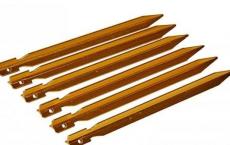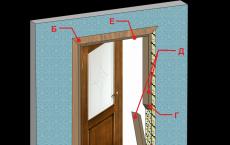How and how to paint the lining inside the house in the country
More recently, it seemed that natural wood, as a finishing material, has sunk into oblivion. But quickly fed up with plastic panels and a variety of tiles, many have come to the conclusion that sustainable wood is the best solution. This is especially true for private and country houses, where you want to be in unity with nature, not only outside the home, but also indoors. However, natural material needs additional processing. Therefore, more and more often the question arises of how to paint the lining inside the house in the country.
Indeed, why additionally process products that have an excellent decorative appearance. But there are several reasons that say that this procedure is simply necessary.
The staining process is divided into two important components: protective and decorative. In the first case, processing of the material is necessary to strengthen its properties, in the second - to give a better decorative look.
 Painting lining is a procedure that has not only a decorative, but a protective function.
Painting lining is a procedure that has not only a decorative, but a protective function. Let us consider in more detail the purpose of each of the compositions:
- The application of flame retardants reduces the flammability of the elements. It is important to understand that it is impossible to completely eliminate the spread of flame.
- Additional treatment with antiseptics is carried out to protect against the appearance of mold and fungi, which leads to damage to the material.
- Waxing and varnishing are dual-use options. On the one hand, they protect the surface from various damages, and on the other hand, they emphasize the decorative appearance of the product.
- Paint work involves hiding the natural color of the wood. This does not mean that the material will lose its appeal. On the contrary, it is possible to diversify the interior, while maintaining the texture of wood.
On a note! Raw elements have a shorter service life, which is sometimes 5-6 years, and even less in the country.
Types of materials for painting
How to paint the lining? It is quite difficult to answer this question. The fact is that there are many compositions that differ in their characteristics. Their correct use can transform the room or, conversely, spoil the whole appearance.
Protective compounds
These solutions act as protectors, but can give a certain decorative effect.
flame retardants
It is necessary to cover such compositions with products that are in places where a fire can occur. Of course, it is better to impregnate all wood materials used in finishing work.
On a note! It is very difficult to apply fire retardants with your own hands, the effect is not so significant. Therefore, preference should be given to elements that are processed in production.
Antiseptics
Substances that eliminate the threat of the appearance of various types of bacteria that contribute to decay and destruction. This solution is great when you want to leave the material unchanged. The composition will protect the product for a long time, so that it will not need additional staining.
 Antiseptic protects lining from various bacteria
Antiseptic protects lining from various bacteria Lucky
In fact, varnishes are already closer to colorful compositions, but they carry a good protective function. Painting lining inside the house can be done with different materials:
- Acrylic lacquer. Great for all interior spaces. It is transparent and translucent. If necessary, the substances can be tinted.
- Synthetic materials. This option requires caution. At the dachas, they cover the premises that are located at the entrance to the house.
Lacquer compositions are quite easy to work with, you just need to take into account that in order to achieve a better result, you need to apply them in several layers.
 Varnish allows you to protect the lining from rotting, damage and destruction
Varnish allows you to protect the lining from rotting, damage and destruction On a note! An excellent solution can be wax, which protects the elements and gives them a rich shade. But applying it is quite difficult, because you have to literally rub it into the surface.
Decorative options
Clapboard paint is the best way to transform a surface that has already lasted a long time. That is, if over time the product began to darken, cracks appeared in places. In this case, it is best to apply paint. As a result, you can completely update the interior of the cottage in the country and bring to life ideas that will help this.
 Painting lining is one of the best protection options, which also performs a decorative function.
Painting lining is one of the best protection options, which also performs a decorative function. How to cover the lining? It should be borne in mind that different types of material can be used for work.
Oil paint
It is considered one of the most popular substances. This option has been used for many decades. This is because the solution has excellent characteristics. They lie in the fact that the composition penetrates deep enough into the upper layers of wood, ensuring its long-term preservation. The coating retains its properties for 7-10 years.
Some disadvantages cannot be ruled out:
- The material has a rich chemical smell that disappears for a very long time.
- The first point leads to the fact that it limits the staining time. That is, it is not possible to work in the winter, because thorough ventilation is required, which can defrost the entire country house.
- The protective property of the paint is fraught with another drawback - the material firmly clogs the pores of the tree, it stops breathing. This means that the microclimate, which is especially valuable when using lining, will be spoiled.
Therefore, for internal work, this composition is used extremely rarely.
It should immediately be noted that this type is very similar to acrylic compositions, but has a lower price and the necessary characteristics.
Such a coloring option has the following properties:
- There is no unpleasant smell that needs long ventilation.
- The coating is much more elastic, which increases the service life. It more successfully resists the aggressive external environment. This is very important, because many country houses remain without heating for the winter period.
- The surface remains breathable, which allows you to maintain the exact atmosphere that is inherent in wooden structures.
- Work is done much faster and easier.
 Acrylic paint allows you to create a flexible, breathable coating
Acrylic paint allows you to create a flexible, breathable coating Of course, such material costs a little more than oil paint, but the result exceeds all expectations.
On a note! To paint the walls from the inside of the house, other options are also used, which contain a note on the label - “for woodworking”. One of these varieties is stain. This is an excellent composition that allows you to saturate the tree with depth, but retain its color and texture.
 Acrylic paint for woodwork
Acrylic paint for woodwork How staining is done
How to paint the lining so that the effect is long and impressive? For such an event, you will need a set of tools:
- Set of brushes and roller. If possible, then the spray gun.
- Tray. To make it easier to pick up paint.
- Protective and decorative compositions.
- Sandpaper, hard brush.
- It is better to provide a stable stepladder and goggles to protect your eyes.
 The use of an airbrush allows you to quickly complete the work on painting the lining
The use of an airbrush allows you to quickly complete the work on painting the lining Coloring consists of several stages. Much more difficult when the work is done on the old coating. Then it becomes necessary to remove the old decorative layer and clean the surface well.
Stage one - preparation
Purchased products are checked for possible damage and deformation. It often happens that materials are bought that belong to a lower class. They require a long preparation - they are processed with sandpaper, the cracks are smeared. If there are dark spots on the surface, bleaching is performed.
On a note! You need to be careful about the presence of knots. Sometimes it seems that these inclusions give a certain charm to the material, but they can cause defects.
 If the material has defects in the form of cracks, then they are eliminated with putty
If the material has defects in the form of cracks, then they are eliminated with putty Stage two - primer
It is necessary to cover the front side of the lining with priming compounds. This will reduce the consumption of other solutions, increase adhesion, and will also prevent the elements from being deformed. At the same time, special attention is paid to knots, they are literally impregnated to exclude the possibility of falling out if drying occurs.
 The primer improves adhesion when painting lining
The primer improves adhesion when painting lining Stage three - impregnation
Now apply protective impregnations. These are flame retardants and antiseptics. Impregnation is carried out over the entire surface. We must not allow unpainted places to remain. It is important to consider that such products should not have extraneous (pungent) odors and change the color of the tree.
On a note! Many mistakenly believe that it is possible to exclude the process of applying an antiseptic if you purchase a primer that already includes this substance. First, the content of such components in the primer is negligible. Secondly, careful processing is necessary for giving.
 When applying protective impregnation, it is necessary to ensure that there are no untreated areas
When applying protective impregnation, it is necessary to ensure that there are no untreated areas Stage four - coloring
How to paint lining inside the house? This procedure begins only after the material dries well from previous manipulations. The process is:
- The paint is prepared in advance. The solution must be well placed, because at the bottom there may be a sediment, which includes the main components.
- A small part of the composition is poured into the tray if a roller is used. For a brush, it is better to provide a container that is easy to carry with you. The use of an airbrush makes the work better, and the paint is poured into a special container.
- It should be borne in mind that the movements are performed along the fibers of the material. You can not linger in one place, the coverage should be uniform.
- Several layers are applied, this will provide an excellent decorative effect.
 To obtain a good decorative effect, the paint should be applied in several layers.
To obtain a good decorative effect, the paint should be applied in several layers. On a note! Each subsequent layer is applied only when the previous one dries. It is better to resist the temptation to apply one, but a very thick layer. This will lead to the fact that the coating will begin to peel off, while the view will be completely unpresentable.
Still, how to cover the lining? This question is quite complex, the answer to it depends on many factors that are calculated purely individually. But it must be borne in mind that if the composition is used over large areas, then it must necessarily ensure the “breathing” of the material.



